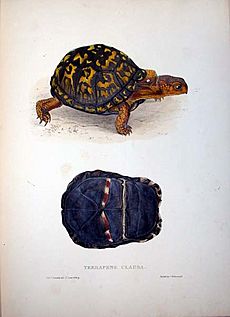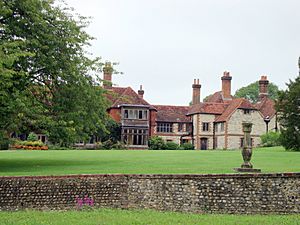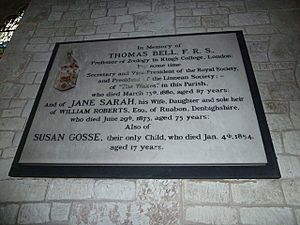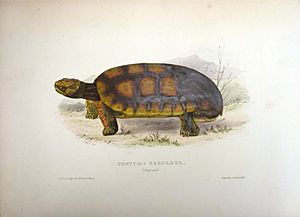Thomas Bell (zoologist) facts for kids
Quick facts for kids
Thomas Bell
|
|
|---|---|
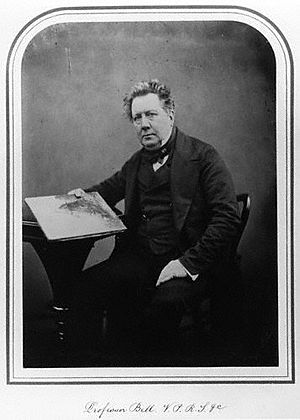 |
|
| Born | 11 October 1792 |
| Died | 13 March 1880 (aged 87) Selborne, England
|
| Known for | British Stalke-eyed Crustacea |
| Spouse(s) | Jane Roberts (scientific illustrator) |
| Children | One daughter, Susan Gosse |
| Relatives | Philip Henry Gosse (cousin) |
| Awards | Fellow of the Royal College of Surgeons and of the Linnean Society (president) |
| Scientific career | |
| Institutions | King's College London, Guy's Hospital, London |
| Author abbrev. (zoology) | Bell |
Thomas Hornsey Bell was an important English zoologist, a dental surgeon, and a writer. He was born in Poole, England, on October 11, 1792. He became a member of the Royal Society and the Linnean Society, which are very respected scientific groups. Thomas Bell is famous for his work studying animals, especially creatures like crabs and lobsters. He passed away on March 13, 1880, in Selborne, England.
Contents
Thomas Bell's Exciting Career in Science
Thomas Bell loved nature, just like his mother, Susan. He even encouraged his younger cousin, Philip Henry Gosse, to explore natural history too. In 1813, Thomas left his hometown of Poole to train as a dental surgeon in London.
He managed to have two careers at once! By 1836, he became a Professor of Zoology at King's College London. He also taught about anatomy (the study of body structures) at Guy's Hospital. In 1844, he became a member of the Royal College of Surgeons, a group for top surgeons. Later, in 1858, he was chosen to be the President of the Linnean Society, a major science organization.
Working with Charles Darwin and the Beagle Voyage
Thomas Bell was a central figure in the science world. When Charles Darwin returned to London in 1836 after his famous Beagle journey, Bell quickly offered to study the reptile specimens Darwin had collected. He also took on the task of describing the Crustacea (like crabs and shrimp) that Darwin found.
Bell was an expert in this area. His book, British Stalke-eyed Crustacea, is considered a masterpiece. He played a key role in helping Darwin develop his idea of natural selection. In 1837, Bell confirmed that the giant Galápagos tortoises were truly native to the islands. Darwin had thought that sailors might have brought them there for food.
Bell also helped with the publication of Darwin's book, Zoology of the Voyage of H.M.S. Beagle. However, he was quite slow in finishing his parts of the work. His section on reptiles was published in 1842 and 1843, but he never completed his work on the Crustacea.
A Famous Meeting: Darwin and Wallace's Theories
As President of the Linnean Society, Thomas Bell led a very important meeting on July 1, 1858. At this meeting, Charles Darwin and Alfred Russel Wallace's groundbreaking ideas about natural selection were first shared with the scientific community. They presented their papers together, explaining how species change over time.
Interestingly, Bell didn't seem to realize how important this moment was. In his report a year later, he wrote that the past year "has not, indeed, been marked by any of those striking discoveries which at once revolutionize... science." He didn't see that Darwin and Wallace's ideas would completely change how people understood life on Earth!
Retirement and a Famous Naturalist's Home
When he was almost 70 years old, Thomas Bell retired to a house called The Wakes in Selborne. This house was special because it used to be home to another famous naturalist, Gilbert White. Bell became very interested in White's work. In 1877, he published a new edition of White's famous book, The Natural History of Selborne. Thomas Bell passed away in Selborne in 1880.
Thomas Bell's Family Life
Thomas Bell married Jane Sarah Roberts on December 3, 1832. They had one daughter named Susan Gosse, who was born in 1836. Sadly, Susan passed away before her parents in 1854. Jane, Thomas's wife, died in 1873.
Jane was also talented; she was a scientific illustrator. She drew pictures for some of Thomas Bell's books and articles, signing her work as Jane S. Bell.
Thomas Bell's Lasting Legacy
Thomas Bell's contributions to science are remembered today. Several species and subspecies of reptiles have been named after him! This is a way for scientists to honor his important work.
Here are some of the animals named after him:
- Chrysemys picta belli, a type of turtle
- Gonocephalus bellii, a type of lizard
- Kinixys belliana, a type of tortoise
- Leiolepis belliana, a type of lizard
- Leiosaurus bellii, a type of lizard
- Liolaemus bellii, a type of lizard
- Myuchelys bellii, a type of turtle
- Plestiodon lynxe bellii, a type of lizard
Thomas Bell's Published Works
One of Thomas Bell's most important books was A Monograph of the Testudinata, published between 1832 and 1836. This book summarized all the known turtles in the world, both living and extinct. The book included 40 detailed drawings by his wife, Jane S. Bell, along with other artists like James de Carle Sowerby and Edward Lear.
See also
 In Spanish: Thomas Bell para niños
In Spanish: Thomas Bell para niños
- Category:Taxa named by Thomas Bell (zoologist)


